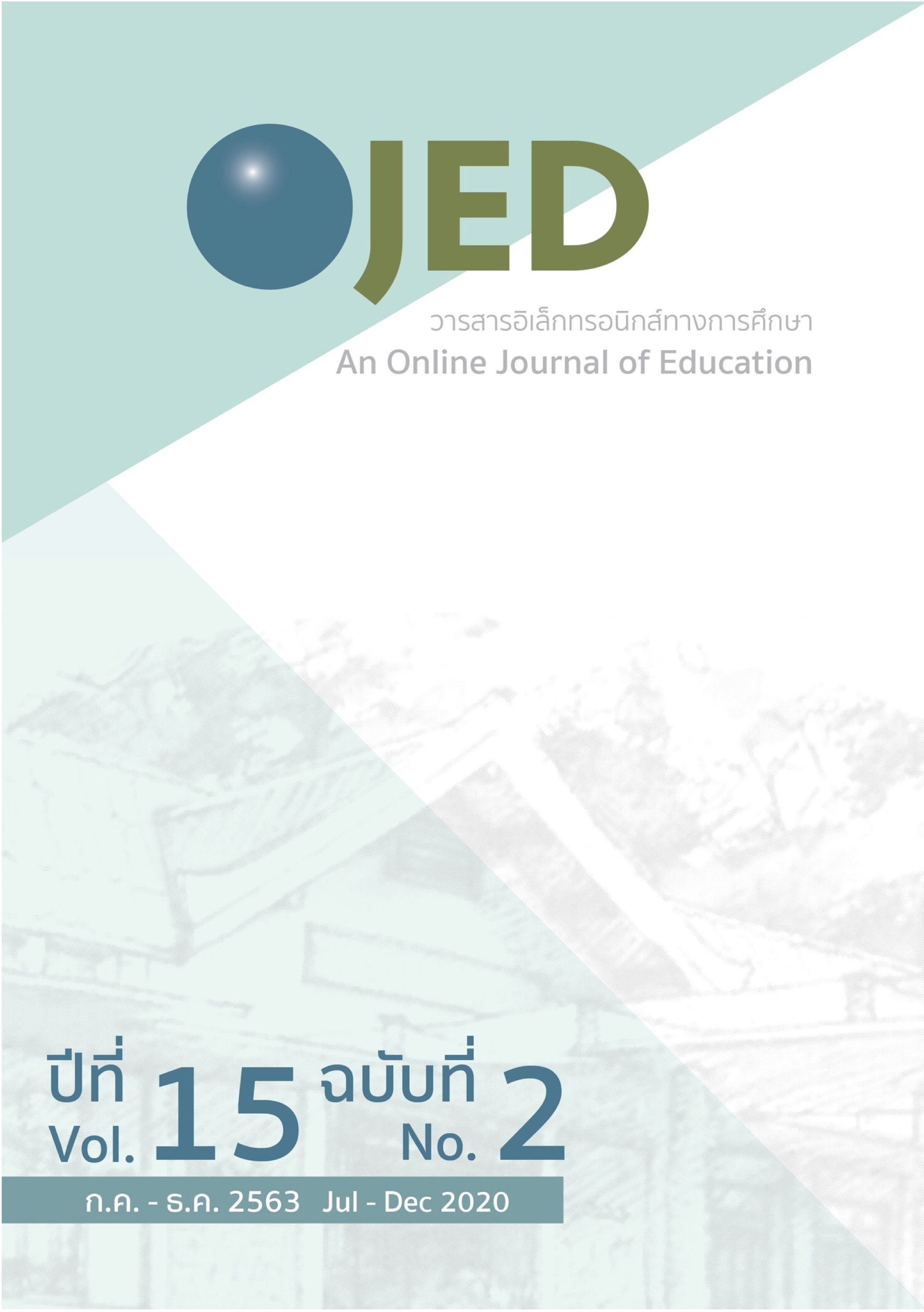Development of Scientific Modeling Ability of Lower Secondary School Students through the Predict Share Observe Explain Instructional Model
DOI:
https://doi.org/10.14456/ojed.2020.46Keywords:
predict share observe explain instructional model, scientific modeling abilityAbstract
This study was a pre-experimental research, making use of a one-group pretest-posttest time-series design. The purposes of this study were 1) to study the scientific modeling ability of lower secondary school students who learned through the predict-share-observe-explain instructional model 2) to compare scientific modeling ability of lower secondary school students who learned through the predict-share-observe-explain instructional model during the learning by repeated measurements 4 times. The target group was 25 students, grade 7 students of a demonstration school in Bangkok who studied in the first semester of academic year 2020. The research instrument is predict-share-observe- explain instructional model lesson plans. The research instruments for collecting data were 1) a scientific modeling ability test 2) a scientific modeling ability assessment and 3) predict-share-observe-explain instructional model lesson plans. The research results were as follows: 1) the scientific modeling ability of the students who learned through the predict share observe explain instructional model was higher than before the experiment and rated at an excellent level at percentage of 83.73 at .05 level of significance; 2) the mean of the assessment of modeling ability score from the four measurements was not statistically significant at the .05 level and rated at a good level at percentage of 76.6.
References
กระทรวงศึกษาธิการ. (2557). แนวปฏิบัติการวัดและประเมินผลการเรียนรู้ ตามหลักสูตรแกนกลางการศึกษาขั้นพื้นฐาน พุทธศักราช 2551. ชุมนุมสหกรณ์การเกษตรแห่งประเทศไทย.
กระทรวงศึกษาธิการ. (2560). ตัวชี้วัดและสาระการเรียนรู้แกนกลาง กลุ่มสาระการเรียนรู้วิทยาศาสตร์ (ฉบับปรับปรุง พ.ศ. 2560) ตามหลักสูตรแกนกลางการศึกษาขั้นพื้นฐาน พุทธศักราช 2551. กรุงเทพมหานคร: ชุมนุมสหกรณ์การเกษตรแห่งประเทศไทย.
โกเมศ นาแจ้ง. (2554). ผลการจัดการเรียนการสอนโดยใช้ MCIS ที่มีต่อความสามารถในการสร้างแบบจำลองทางวิทยาศาสตร์และมโนทัศน์เรื่องการเคลื่อนที่และแบบการเคลื่อนที่ของนักเรียนชั้นมัธยมศึกษาตอนปลาย [วิทยานิพนธ์ปริญญามหาบัณฑิต]. Chulalongkorn University Intellectual Repository (CUIR). http://cuir.car.chula.ac.th/handle/123456789/22025
ณัฏฐ์นภันต์ กตัญรัตน์. (2558). การศึกษามโนมติทางวิทยาศาสตร์และความสามารถในการสร้างแบบจำลองทางวิทยาศาสตร์โดยใช้การจัดการเรียนรู้แบบ MIS เรื่อง ไฟฟ้าเคมีของนักเรียนชั้นมัธยมศึกษาปีที่ 5. KU Research Journal (Graduate Studies) Humanities and Social Sciences. 3(1), 82-92. https://so04.tci-thaijo.org/index.php/gskkuhs/article/view/59875
สถาบันส่งเสริมการสอนวิทยาศาสตร์และเทคโนโลยี. (2556). คู่มือการใช้หลักสูตรวิทยาศาสตร์ฉบับอนาคต ชั้นมัธยมศึกษาปีที่1. http://www.ipst.ac.th/files/curriculum2556/ManualScienceM1.pdf
หนึ่งฤทัย เกียรติพิมล. (2559). ผลของการใช้แนวคิดการสร้างตัวแทนความคิดที่มีต่อความสามารถในการสร้างแบบจำลองและผลสัมฤทธิ์ทางการเรียนชีววิทยาของนักเรียนมัธยมศึกษาตอนปลาย [วิทยานิพนธ์ปริญญามหาบัณฑิต]. Chulalongkorn University Intellectual Repository (CUIR). http://cuir.car.chula.ac.th/handle/123456789/55143
Acher, A., Arcà, M., & Sanmartí, N. (2007). Modeling as a teaching learning process for understanding materials: A case study in primary education. Science Education, 91(3), 398-418.
Baek, H., Schwarz, C., Chen, J., Hokayem, H., & Zhan, L. (2011). Engaging elementary students in scientific modeling: The MoDeLS fifth-grade approach and findings. In Models and modeling (pp. 195-218). Springer.
Brown, P. L., & Concannon, J. (2016). Students use of the PSOE model to understand weather and climate. Science Activities, 53(3), 87-91.
Chang, S. N. (2008). The learning effect of modeling ability instruction. Asia-Pacific Forum on Science Learning & Teaching, 9(2), 1-21. https://www.eduhk.hk/apfslt/download/v9_issue2_files/changsn.pdf
Khan, S. (2011). What’s missing in model-based teaching. Journal of Science Teacher Education, 22(6), 535-560.
Papaevripidou, M., Nicolaou, C. T., & Constantinou, C. P. (2014, April). On defining and assessing learners’ modelling competence in science teaching and learning. [Paper presentation]. In Annual Meeting of American Educational Research Association (AERA), Philadelphia, Pennsylvania, USA.
Schwarz, C. V., Reiser, B. J., Davis, E. A., Kenyon, L., Achér, A., Fortus, D., & Krajcik, J. (2009). Developing a learning progression for scientific modeling: Making scientific modeling accessible and meaningful for learners. Journal of Research in Science Teaching: The Official Journal of the National Association for Research in Science Teaching, 46(6), 632-654.
Treagust, D., Chittleborough, G., & Mamiala, T. (2003). The role of submicroscopic and symbolic representations in chemical explanations. International Journal of Science Education, 25(11), 1353-1368.
Downloads
Published
How to Cite
Issue
Section
License
Copyright (c) 2020 An Online Journal of Education

This work is licensed under a Creative Commons Attribution-NonCommercial-NoDerivatives 4.0 International License.




